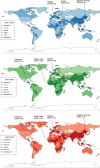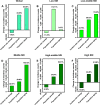The spatiotemporal dynamics of lung cancer: 30-year trends of epidemiology across 204 countries and territories
- PMID: 35578216
- PMCID: PMC9109351
- DOI: 10.1186/s12889-022-13281-y
The spatiotemporal dynamics of lung cancer: 30-year trends of epidemiology across 204 countries and territories
Abstract
Background: It has been established that lung cancer is the leading cause of all cancer deaths. This study sought to analyze the epidemiological trends of lung cancer over the past 30 years worldwide.
Methods: Estimates, including the global, regional, national prevalence, incidence, and years lived with disability (YLDs) of lung cancer from 1990 to 2019, were extracted from the Global Burden of Disease Study 2019 to assess the spatiotemporal dynamics in cases and age-standardized rates (ASR). The estimated annual percentage change (EAPC) was calculated to evaluate the variation in ASR. Besides, estimates of age-sex specific prevalence, decomposition analysis for incident cases, and correlation analysis of the EAPC were conducted in our study.
Results: Globally, the ASR of lung cancer prevalence, incidence and YLDs in 2019 were 38.84/100,000 persons, 27.66/100,000 persons, and 6.62/100,000 persons, respectively. Over the past 30 years, the ASR of incidence (EAPC = -0.09) decreased, although that of prevalence (EAPC = 0.51) and YLDs (EAPC = 0.03) increased. The global prevalence counts was greater in males than females at all age groups and increased with age, peaking in the 65-69 age group for both sexes. The increase in incidence was mainly attributed to population aging. For YLDs, EAPC was negatively correlated with the human development index (p = 0.0008) and ASR (p < 0.0001) in 1990 across nation-level units.
Conclusions: Lung cancer remains a major public health issue globally, warranting the implementation of scientific and effective measures in different countries and territories to control it.
Keywords: Incidence; Lung cancer; Prevalence; Spatiotemporal dynamics; Years lived with disability.
© 2022. The Author(s).
Conflict of interest statement
The authors declare no potential conflicts of interest.
Figures






References
-
- Sung H, Ferlay J, Siegel RL, Laversanne M, Soerjomataram I, Jemal A, Bray F. Global Cancer Statistics 2020: GLOBOCAN estimates of incidence and mortality worldwide for 36 cancers in 185 countries. CA Cancer J Clin. 2021;71(3):209–249. - PubMed
Publication types
MeSH terms
LinkOut - more resources
Full Text Sources
Medical
Miscellaneous

